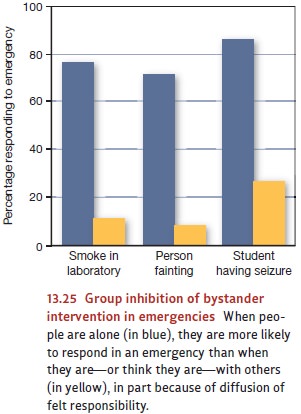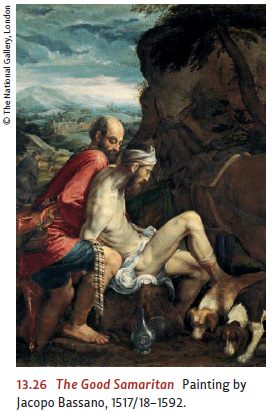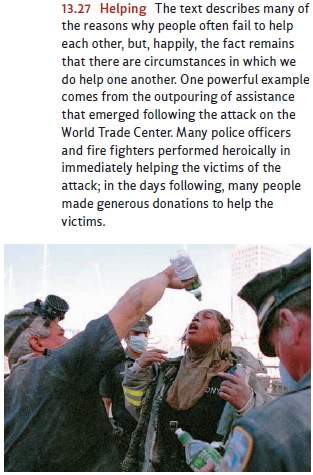Chapter: Psychology: Social Psychology
Social Relations: Helping and Altruism
Helping and Altruism
One
of our great sources of pride as a species is our ability to exhibit prosocial behav-iors, behaviors that
help others—assisting them in their various activities, supporting and aiding
them in their time of need. But, of course, we don’t always help. Sometimes we
ignore the homeless man as we walk by him; sometimes we throw away a charity’s
fundraising plea; sometimes we scurry past the person who has just dropped his
groceries. The question we need to ask, then, is why we sometimes help and
sometimes don’t. The answer, once again, involves a mix of factors—including
our personalities (whether we tend to be helpful overall) and our social
environment.
THE BY
STANDER EFFECT
Consider
the case of Kitty Genovese, who was attacked and murdered one early morn-ing in
1964 on a street in Queens, New York (Figure 13.24). While the details of the
case are disputed (Manning, Levine, & Collins, 2007), it is clear that the
assault lasted over half an hour, during which time Genovese screamed and
struggled while her assailant stabbed her repeatedly. Many of her neighbors
could see or hear her struggle but did not come to her aid. Why not? Why, in
general, do we often fail to help those who are obviously in need—perhaps even
in extreme danger?

According
to Latané and Darley, the failure to help is often produced by the way peo-ple
understand the situation. It’s not that people don’t care. It’s that they don’t
under-stand what should be done because the situation is ambiguous. In the
Genovese case, witnesses later reported that they were not sure what was
happening. Perhaps it was a joke, a drunken argument, a lovers’ quarrel. If it
were any of these, intervention might have been very embarrassing.
The
situation is further complicated by the fact that the various witnesses to the
Genovese murder realized that others were seeing or hearing what they did. This
circumstance created pluralistic
ignorance. Each of the witnesses was uncertain whether there really was an
emergency, and each looked to the others, trying to decide. Their rea-soning
was simple: “If my neighbors don’t react, then apparently they’ve decided
there’s no emergency, and, if there’s no emergency, there’s no reason for me to
react.” The tragedy, of course, is that the neighbors were thinking roughly the
same thoughts—with the consequence that each took the inactivity of the others
as a cue to do nothing.
Even
when people are convinced that they
are viewing an emergency, the presence of multiple bystanders still has an
effect. It creates a diffusion of responsibility,
with each bystander persuaded that someone else will respond to the emergency,
someone else will take the responsibility. This effect is illustrated by a
study in which participants were asked to join in what they thought was a group
discussion about college life with either one, three, or five other people.
Participants sat in individual cubicles and took turns talking to each other
over an intercom system. In actuality, though, there was only one participant;
all the other speakers were voices on a previously recorded tape. The
discussion began as one of these other speakers described some of his personal
prob-lems, which included a tendency toward epileptic seizures in times of
stress. When he began to speak again during the second round of talking, he
seemed to have a seizure and gasped for help. At issue was what would happen
next. Would the actual partici-pant take action to help this other person
apparently in distress?
The
answer was powerfully influenced by the “crowd size.” If the participant
believed that she had been having just a two-way discussion (so that there was
no one else around to help the person in distress), she was likely to leave her
own cubicle to help. But if the participant thought it was a group discussion,
a diffusion of responsibility occurred, and the larger the group the
participant thought she was in, the less likely she was to come to the victim’s
assistance (Darley & Latané, 1968).
This
bystander effect has been
demonstrated in numerous other situations. In some, an actor posing as a fellow
participant seems to have an asthma attack; in others, someone appears to faint
in an adjacent room; in still others, the laboratory fills with
smoke.
Whatever the emergency, the result is always the same. The larger the group the
participant is in (or thinks he is in), the smaller the chance that he will
take any action (Latané & Nida, 1981; Latané, Nida, & Wilson, 1981;
Figure 13.25).

One
important qualification, however, is that larger (perceived) groups seem to
breed less helping only when the group members are strangers. When group
mem-bers are familiar others, larger group size can actually encourage helping
behavior (M. Levine & Crowther, 2008). But this, too, makes sense if we
consider the costs of not helping and
the benefits of helping. First, your
not taking action shifts the burden to someone else in the crowd—and if that
other person is someone you’re familiar with, you may feel uncomfortable
imposing on them in this way. Second, there’s likely to be some embarrassment
at not helping in an emergency situation, and that embarrassment grows if you
are with people you will be seeing again. Finally, taking action among friends
has the benefit of enhancing social cohesion and increasing a sense of pride in
group membership. Whether among strangers or friends, then, it appears that the
social setting guides your actions.
THE COST OF HELPING
Our
last example highlighted some of the costs of not helping, but there is also often a cost of helping—and both of
these costs shape our behavior. In some cases, the cost of helping lies in
physical danger—if, for example, you need to leap into an icy river to help
someone who is drowning. In others, the cost is measured simply in time and
effort. In all cases, though, the pattern is simple. The greater the cost of
helping and the smaller the cost of not helping, the smaller the chance that a
bystander will offer help to someone in need.
In
one study, for example, students had to go one at a time from one campus
build-ing to another to give a talk. They were told to hurry, since they were
already late. As students rushed to their appointments, they passed a shabbily
dressed man lying in a doorway groaning. Only 10% of the students stopped to
help this disguised confeder-ate. Ironically, the students were attending a
theological seminary, and the topic of their talk was the parable of the Good
Samaritan who came to the aid of a man lying injured on a roadside (Figure
13.26). It appears that if the cost—here in time—is high enough, even
theological students may not behave altruistically (Darley & Batson, 1973).

What is costly to one potential helper may not be equally so to another, however. Take physical danger. It is probably not surprising that bystanders who intervene in assault cases are generally much taller, stronger, and better trained to intervene than bystanders who do not intervene, and they are almost invariably men (Eagly & Crowley, 1986; Huston, Ruggiero, Conner, & Geis, 1981).
In
addition, the costs of providing help are sometimes weighed against the benefits of helping. Some of the
benefits are various signs of social approval, as with a donor to charity who
is sure to make a lavish contribution so long as everyone knows. A differ-ent
benefit is one we alluded to earlier—namely, the avoidance of shame or
embarrass-ment. Many city dwellers give 50 or 75 cents to a homeless person,
for example, not because they want to help but because it would be embarrassing
just to say no. Occasionally, the benefits of giving involve sexual attraction.
In one study, the investi-gators posed as motorists in distress trying to flag
passing cars to provide help with a flat tire. The passing cars were much more
likely to stop for a woman than for a man, and the cars that stopped were
generally driven by young men alone. The best guess is that the young men’s
altruism was not entirely unalloyed by sexual interest (West, Whitney, &
Schnedler, 1975).
One
additional factor that shapes whether people help each other is their cultural
context. Compared to Hindu Indians, for example, European Americans are less
likely to see that they have a moral imperative to help someone if they do not
like that person (J. G. Miller & Bersoff, 1998). European Americans also
see less of a moral imperative to help someone who has helped them in the past
(J. G. Miller, Bersoff, & Harwood, 1990). And because of the cultural
emphasis on taking care of “number one,” Americans will say that they are
acting out of self-interest, even when they are not (D. T. Miller, 1999).
Overall, these findings suggest that cultural emphasis on self-reliance and
self-interest may cause Americans and other members of individualistic
societies to think twice before helping, while the cultural emphasis on
relationships and connection may cause members of collectivistic societies to
offer aid more readily.
ALTRUISM AND SELF - INTEREST
The
preceding discussion suggests a somewhat unflattering portrait of human nature,
especially for those of us in individualistic cultures. It seems that we often
fail to help strangers in need, and when we do, our help is rather grudging and
calculated, based on some expectation of later reciprocation. But that picture
may be too one-sided. For while people can be callous and indifferent, they are
also capable of true generosity and even, at times, of altruism, or helping behavior that does not benefit the helper
(Figure 13.27). People share food, give blood, contribute to charities,
volunteer at AIDS hospices, and resuscitate accident victims. Even more
impressive are the unselfish deeds of living, genetically unrelated donors who
give one of their kidneys to a stranger who would oth-erwise die (Sadler,
Davison, Carroll, & Kounts, 1971). Consider too those commemorated by
Jerusalem’s Avenue of the Righteous—the European Christians who sheltered Jews
during the Holocaust, risking (and often sacrificing) their own lives to save
those to whom they gave refuge (London, 1970).

Why
do people engage in these activities? When asked, most report that such
altruistic actions make them better people (Piliavin & Callero, 1991; M.
Snyder & Omoto, 1992), and the major texts of all major religions support
this idea (Norenzayan & Shariff, 2008). Such acts of altruism suggest that
human behavior is not always selfish. To be sure, acts of altru-ism in which
the giver gets no benefits at all—no gratitude, no public acclaim—are fairly
rare. The true miracle is that they occur at all.
Related Topics